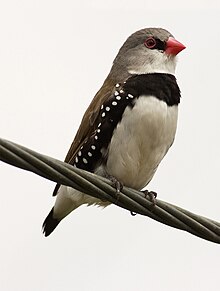Diamond finches
| Diamond finches | ||||||||||||
|---|---|---|---|---|---|---|---|---|---|---|---|---|

|
||||||||||||
| Systematics | ||||||||||||
|
||||||||||||
| Scientific name | ||||||||||||
| Stagonopleura | ||||||||||||
| Reichenbach , 1850 |
The diamond finches ( Stagonopleura ), also called diamond amadines , are an Australian genus from the family of the magnificent finches . While the fire tail and red-eared amadine are classified as harmless by the IUCN, the diamond finch is considered to be a near threatened species due to habitat destruction .
description
Diamond finches reach a body length between eleven and twelve centimeters. The individual species are not only similar in size, but also in their body shape. All have either conspicuously dotted or finely corrugated undersides of the body. Your rump and the upper tail-coverts are red. The throat drawing of the nestlings is also similar. All three species also have a red beak in common. There is no pronounced sexual dimorphism in any species.
Distribution and way of life
All three species colonize Australia . The red-eared amadine is found exclusively in a narrow band on the southwestern coast of the Australian continent. It has the smallest range of all Australian finches. The distribution area of the fire tailed amadine is southeast Australia between Adelaide and Sydney . This species is also found on Kangaroo Island and Tasmania . The diamond finch is found in the dry forest areas of eastern and southern Australia.
The red-eared amadine is the most specialized species of all Australian finches. It prefers to inhabit the clearings of eucalyptus forests with dense shrub-like undergrowth. It is particularly common there at the bottom of valleys with narrow watercourses. It occurs less often in bush and heather vegetation as well as swamp areas. The fire tailed amadine lives in open habitats and is somewhat less specialized than the red-eared amadine when it comes to their demands on their biotope. Similar to the red-eared amadine, it prefers the immediate vicinity of water and is often found on the banks of rivers and lakes. The habitat of the diamond finch are areas with sparse trees and a relatively dense vegetation of shrubs. Of all three species, they show the least water-bound way of life.
attitude
The animal dealer Christiane Hagenbeck was involved in the first importation of all three species to Germany, which fell in the 1870s . The red-eared amadine has not been introduced since then and the fire-tailed amadine is now kept relatively rarely. The diamond finch, on the other hand, is more important in the ornamental bird trade. It is being pulled in larger numbers in Europe. The number of offspring for this species between 1984 and 1987 was between 1,000 and 1,500 young birds per year. In the 1990s, however, the number of offspring declined. In 1995, for example, only 362 diamond finches were bred.
species
The following species are counted among the diamond finches:
- Diamond finch ( S. guttata )
- Fire tail amadine ( S. bella )
- Red-eared Amadine ( S. oculata )
supporting documents
literature
- Jürgen Nicolai (Ed.), Joachim Steinbacher (Ed.), Renate van den Elzen, Gerhard Hofmann: Prachtfinken - Australia, Oceania, Southeast Asia. Eugen Ulmer Verlag, Stuttgart 2001, ISBN 3-8001-3249-4 .
- Peter Clement , Alan Harris, John Davis: Finches and Sparrows. An Identification Guide. Christopher Helm, London 1993, ISBN 0-7136-8017-2 .
Web links
- BirdLife Factsheet , accessed June 21, 2010

